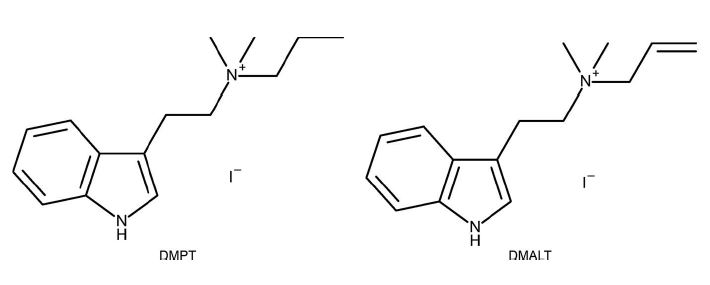
The psychedelic research company CaaMTech has published in Acta Crystallographic E, the crystal structures of the iodide salts of the quaternary tryptammonium compounds DMPT and DMALT.1 This study adds to the growing body of scientific work on structurally related tryptamine compounds that the company has published since early 2019.2–10
DMPT and DMALT are structural analogs of the quaternary tryptammonium toad secretion bufotenidine and the magic mushroom compound aeruginascin. The latter two compounds have recently entered the psychedelic research arena due to their natural occurrence in living organisms alongside other psychedelic tryptamines, including bufotenin and psilocybin.
Chemically, the compounds are known as N,N-dimethyl-N-propyltryptammonium iodide (DMPT iodide), and N,N-dimethyl-N-allyltryptammonium iodide (DMALT iodide). Each crystal structure comprises one cation of the compound and one iodide anion (Figure 1).

Figure 1: The chemical structures of the salts DMPT iodide and DMALT iodide.1
In the press release, CaaMTech says these are “the world’s first crystal structures of unsubstituted quaternary tryptammonium salts.”
Why Solve the Crystal Structures of these Salts?
Dr. Andrew Chadeayne, CEO of CaaMTech and lead author of the study, explained that “In nature, quaternary tryptammonium compounds are present alongside their better-known tertiary amine analogs, like psilocybin or psilocin; but their pharmacology has not been studied. Adding DMPT and DMALT to CaaMTech’s library of unique tryptamines creates new opportunities for drug development and personalized medicine.”
As part of this study, Dr. Chadeayne and his team also published the synthesis methods for making DMPT iodide and DMALT iodide. This advancement in psychedelic chemistry lets labs synthesize the compounds themselves for use in research studies.
Crystal Structures in the Big Picture of Psychedelic Research
Crystal structures are essential for helping researchers ‘see’ what’s going on at a molecular level. This view gives them a better understanding of how receptors and compounds look and act in nature. Making small changes at the molecular level can translate into significant changes in the effects. Therefore, working with compounds at the molecular level is essential for understanding the mechanisms of how drugs work and how other compounds affect them.
